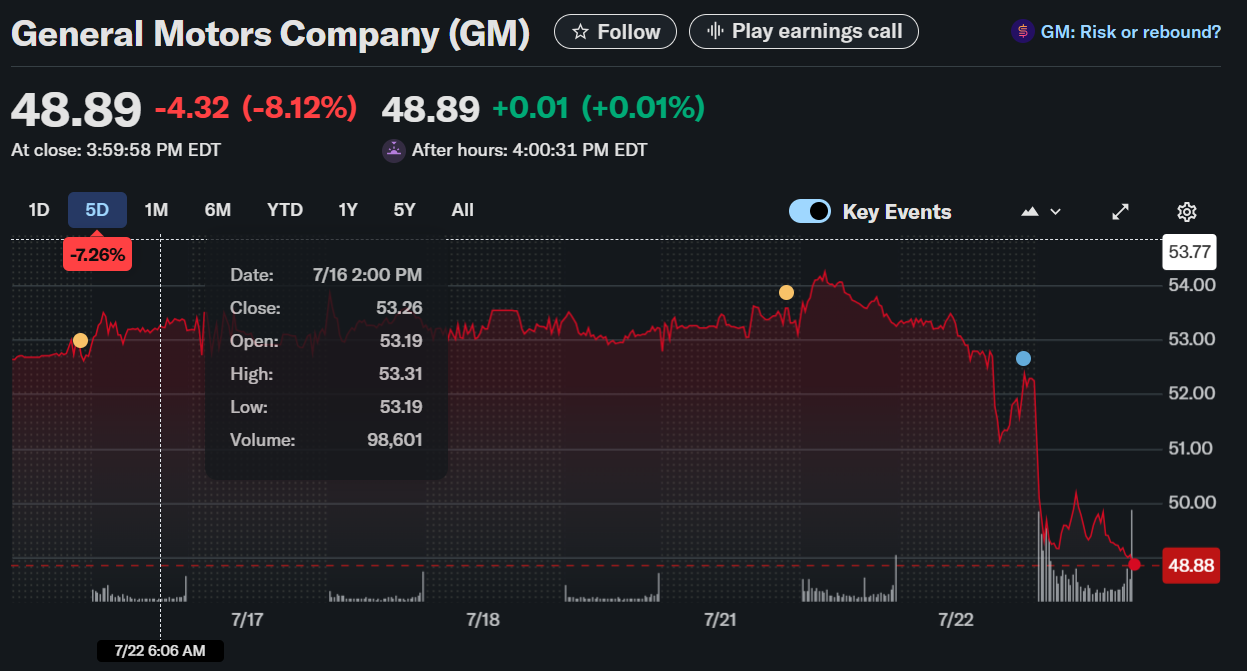GM Stock Tanks 7.85%: $1.1B Tariff Gut Punch Obliterates Q2 Earnings
Another day, another legacy automaker getting steamrolled by geopolitical headwinds.
General Motors just became the latest casualty in the trade war circus, with its stock plunging nearly 8% after getting blindsided by $1.1 billion in fresh tariffs. The market's verdict? A brutal sell-off that left Q2 profits bleeding on the pavement.
Wall Street's reaction was predictably dramatic - because nothing gets financiers more excited than watching industrial giants take body blows to their bottom line. The 'efficient market' at work, folks.
Meanwhile in crypto-land: Bitcoin holders sip their coffee, watching traditional finance rediscover volatility the hard way.
TLDR
- GM Shares Drop as Tariffs Slash Q2 Profits Despite Sales Strength in U.S., China
- Tariffs Cut Deep: GM Q2 Profit Falls 32% but EVs and Sales Provide Support
- GM Beats Earnings Forecasts, Warns of Tariff Woes Through End of 2025
- GM Reshapes Strategy Amid Tariffs, Expands U.S. Output, Doubles EV Sales
- GM Battles Tariffs With Cost Cuts, U.S. Expansion, and BEV Market Gains
General Motors shares tumbled 7.85% Tuesday, closing at $49.03 after reporting steep Q2 profit declines.

General Motors (GM)
Tariffs imposed earlier this year cost the automaker $1.1 billion in the quarter, dragging net income down 32% from last year. While the company beat earnings forecasts, it warned of continued pressure from trade policies through the rest of 2025.
Tariffs Hammer Quarterly Earnings and Outlook
GM reported a second-quarter profit of $2.53 per share, down from $3.06 in Q2 2024, but still above analyst expectations. The automaker blamed WHITE House-imposed tariffs on imported vehicles and components for $1.1 billion in added costs. Management projects total tariff costs will reach between $4 billion and $5 billion this year.
GM plans to offset 30% of the burden through aggressive cost-cutting efforts across operations. The company is recalibrating product strategy and manufacturing alignment as new trade rules reshape the landscape. Despite the earnings hit, GM affirmed its long-term commitment to strategic goals.
The company also confirmed that tariff-related expenses WOULD remain elevated through year-end. Restructuring and relocation efforts will take time to impact cost savings. GM continues adapting its global footprint to respond to the current trade environment.
Sales Strength in the U.S. and China Supports Revenue
GM’s U.S. sales ROSE 7% in the April to June period compared to the same months last year. The brand saw strong demand for its trucks and SUVs, which supported overall revenue stability during the quarter. GM also returned to profitability in China following last year’s restructuring loss.
In China, GM achieved a small quarterly profit after taking a $5 billion restructuring charge in 2024. The company restructured operations and adjusted its portfolio to regain competitiveness in the world’s largest auto market. Recovery in China supported the overall financial performance despite higher global production costs.
Sales growth in Core markets helped balance the impact of tariffs on earnings. However, GM acknowledged that longer-term profitability depends on completing its production realignment. It has started investing in new U.S. plants to reduce overseas assembly reliance.
Production Shifts Begin as Tariffs Reshape Operations
GM committed $4 billion to expand production capacity in Kansas, Michigan, and Tennessee. These moves aim to reshore 300,000 vehicles annually that were previously built in Mexico and Canada. The company expects to complete the ramp-up in 18 months.
For over 30 years, automakers benefited from NAFTA and later the USMCA to distribute production across North America. However, new tariffs under the Emergency Powers Act have upended that model, especially for vehicles and auto parts. GM’s new strategy aligns with the reshaped regulatory and political landscape.
The White House framed the tariffs as a response to illegal border activity and the need to reduce trade deficits. GM responded by reorganizing its production network to ensure compliance and preserve profit margins. Leadership views the transition as necessary for long-term success.
EV Momentum and Regulatory Changes Shape Future Plans
Electric vehicle sales at GM more than doubled year-over-year, with Cadillac taking the lead in the premium BEV segment. The brand now holds the top market share in luxury BEVs, overtaking competitors like Tesla. A surge in sales also followed the July budget bill ending EV tax credits in September.
The company expects demand to shift as the $7,500 federal credit expires for models not meeting U.S. content rules. TRUMP administration budget changes also removed penalties tied to fuel economy standards. These shifts enable automakers to focus again on ICE vehicles without facing CAFE fines.

